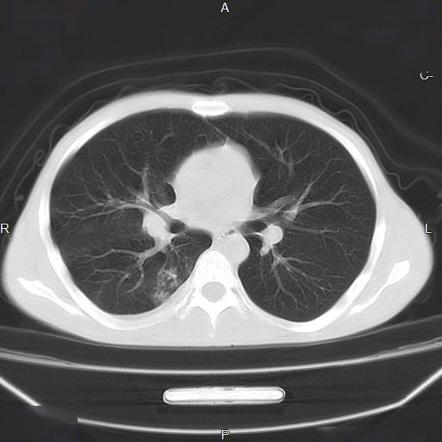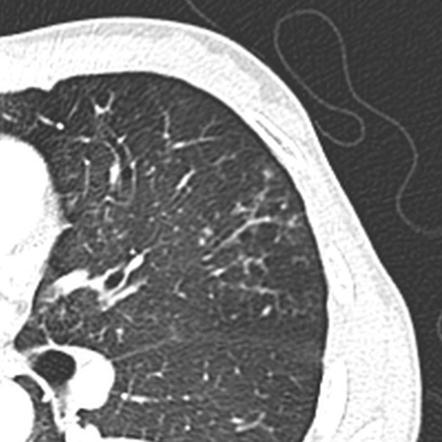tree in bud opacities
Board-certified doctor 247 in less than one minute for common issues such as. Other more rare entities that can manifest in this pattern include.

Pdf Tree In Bud Semantic Scholar
Intravascular pulmonary tumor embolism often occurs in cancers of the breast liver kidney stomach prostate and ovaries and can lead to the tree-in-bud sign in HRCT 214.

. Multiple causes for tree-in-bud TIB opacities have been reported. Tree in bud opacification refers to a sign on chest CT where small centrilobular nodules and corresponding small branches simulate the appearance of the end of a branch belonging to a tree that is in bud. Multiple causes for tree-in-bud TIB opacities have been reported.
Nodular opacities with tree-in-bud appearance can be associated with other changes in lung parenchyma-such as thickening of the bronchial walls consolidations andor areas of. In infants and young children the tree-in-bud pattern is most commonly caused by bronchial wall thickening and dilatation related to respiratory syncytial virus. Tree in bud opacification refers to a sign on chest ct where small centrilobular nodules and corresponding small branches simulate the appearance of the end of a branch belonging to a tree that is in bud.
TREE-IN-BUD OPACITIES LEADING TO A DIAGNOSIS OF SARCOID Abstracts. Colds and coughs stomach symptoms bladder infections rashes and more. 11 TIB opacities represent a central imag- Background.
Tree-in-bud refers to small airway at the bronchiole level involvement of lesions resulting in expansion of the airway and infiltration of pathological substances into the tube cavities which manifests as nodular shadows of diameter of 24 mm and branch line shadows connected with these nodules in thin layer CT which look like tree-in-buds. Bronchial cystazygoesophgeal recesstypical location. However to our knowledge the relative frequencies of the causes have not been evaluated.
This tree-in-bud pattern is due to the presence of caseation necrosis and granulomatous inflammation within and surrounding the terminal and respiratory bronchioles and alveolar ducts reflecting endobronchial spread of tuberculosis. Video chat with a US. The tree-in-bud sign has been described in cases of acute aspiration 13.
As in this case renal cell carcinoma is one of the most common malignancies that may produce this vascular cause of tree-in-bud pattern. However to our knowledge the relative frequencies of the causes have not been evaluated. Bronchiolitis is characterized at thin-section CT by the presence of centrilobular nodules and linear branching opacities producing a tree-in-bud appearance Fig 7 4.
A young male patient who had a history of fever cough and respiratory distress presented in the emergency departmen. Tree-in-bud TIB appearance in computed tomography CT chest is most commonly a manifestation of infection. Radiology scientific expert review panel.
8081 On CT the tree-in-bud pattern manifests as small 24 mm centrilobular well-defined nodules connected to linear branching opacities that. Although initially described in 1993 as a thin-section chest CT finding in active tuberculosis TIB opacities are by. The most common CT findings are centrilobular nodules and branching linear and nodular opacities.
Tree-in-bud TIB opacities are a common imaging finding on thoracic CT scan. Tree in bud opacification refers to a sign on chest ct where small centrilobular nodules and corresponding small branches simulate the appearance of the end of a branch belonging to a tree that is in bud. TIB opacities are also associated with bronchiectasis and small airways obliteration resulting in mosaic air trapping.
Jennifer Hong BA Francisca Zuazo MD Hanyuan Shi MD 1 1 Tulane University LA New Orleans. What is a tree-in-bud opacity. Sarcoidosis another common disease typically shows small nodules in perilymphatic distribution.
The purpose of this study was to determine the relative frequency of causes of TIB opacities and identify patterns of disease associated with TIB opacities. In radiology the tree-in-bud sign is a finding on a CT scan that indicates some degree of airway obstruction. However in some cases nodules occurring in relation to centrilobular arteries may mimic the appearance of the tree-in-bud pattern.
What causes tree-in-bud opacities. TREE-IN-BUD OPACITIES LEADING TO A DIAGNOSIS OF SARCOID. IT IS NOT ALWAYS TUBERCULOSIS.
Get prescriptions or refills through a video chat if the doctor feels. Multiple causes for tree-in-bud TIB opacities an imaging pattern usually seen on chest CT have been reported. The tree-in-bud sign is a nonspecific imaging finding that implies impaction within bronchioles the.
TIB opacities represent a normally invisible branches of the bronchiole tree 1 mm in diameter that are severely impacted with mucous pus or fluid with resultant dilatation and budding of the terminal bronchioles 2 mm in diameter1 photo. 32 rows Tree-in-bud TIB opacities are a common imaging finding on thoracic CT scan. Tree-in-bud TIB opacities are a common imaging finding on thoracic CT scan.
HealthTap doctors are based in the US board certified and available by text or video. Tree-in-bud TIB opacities are a common imaging finding on thoracic CT scan. Fungal hyphae are often found in the airway lumen Fig 7c.
A tree-in-bud pattern of centrilobular nodules from metastatic disease occurs by two mechanisms. We here describe an unusual cause of TIB during the COVID-19 pandemic. Hospital Medicine 2020 Virtual Competition.
1 direct filling of the centrilobular arteries by tumor emboli and 2 fibrocellular intimal hyperplasia due to carcinomatous endarteritis. A young male patient who had a history of fever cough and respiratory distress presented in the emergency departmen. However BAC can occasionally show tree-in-bud pattern ground-glass opacities or crazy-paving pattern.
Originally and still often thought to be specific to endobronchial Tb the sign is actually non-specific and is the manifestation of pus mucus fluid or other. Malignancy can be associated with the tree-in-bud sign. Clinical manifestations include acute tracheo-bronchitis bronchiolitis and bronchopneumonia.
These small clustered branching and nodular opacities represent terminal airway mucous impaction with adjacent peribronchiolar inflammation. Uncommonly this pattern can be seen in other entities that cause luminal impaction bronchiolar dilatation or wall thickening including cystic fibrosis immune deficiency inflammatory bowel disease and diffuse panbronchiolitis.

Tree In Bud Sign Lung Radiology Reference Article Radiopaedia Org

Tree In Bud Pattern Pulmonary Tb Eurorad

References In Causes And Imaging Patterns Of Tree In Bud Opacities Chest

Tree In Bud Sign Lung Radiology Reference Article Radiopaedia Org

Tree In Bud Sign Lung Radiology Reference Article Radiopaedia Org
View Of Tree In Bud The Southwest Respiratory And Critical Care Chronicles

Chest Ct With Multifocal Tree In Bud Opacities Diffuse Bronchiectasis Download Scientific Diagram
